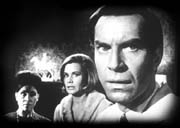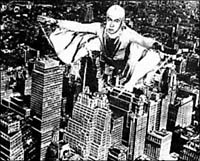Skeptical Inquirer
- Subscribe to the magazine for science and reason - for the Internet price of $19.95
- Index of Articles
- List of Online Articles
- Back Issues
- Author Guidelines
Skeptical Briefs
- Join CSI as an associate member to receive the newsletter
CSI
Special Features
- Camp Inquiry
- Council for Media Integrity
- Intelligent Design Watch
- Inquiring Minds
- Klass Files
- Pensar Magazine
- Skeptic's Toolbox
- Skeptiseum
- Superstition Bash
Web Columns
Center for Inquiry
Resources
The Eyes that Spoke
Martin KottmeyerIn his final book, Aliens from Space (1973), Donald Keyhoe briefly recounted his involvement in starting the investigation of Barney and Betty Hill that eventually led to John Fuller's publication of The Interrupted Journey (1966), the first major work of the alien-abduction mythos. Keyhoe was mystified more than anything else by the hideous faces of the aliens. The heads were oddly shaped with no ears and compressed noses and mouths. Worst of all were the long slanting eyes that extended along the side of the head creating a sinister look. "What caused the subconscious minds of these two people to create these pictures from their imaginations has never been fully explained," he wrote.
Keyhoe could not accept the case 100 percent, he admitted in a 1975 interview, but he did not reject it either. As mysteries go, Keyhoe's question seemed safely rhetorical. Who knows why anyone dreams of one monster and not another? How would anyone even begin to investigate such a problem?
What could not have been foreseen was how serendipity would step in to break this minor mystery. The local PBS station a few years ago decided to rerun the old TV series "The Outer Limits." It was one of the most visually amazing programs of my youth, and I eagerly tuned in to experience once more such sights as the horrifying Zanti misfits, the bee girl, moonstone, Borderland's ionic gale, the downshifting time machine of "Controlled Experiment," and David McCallum's evolution into a megabrain.
 It was during the showing of the "Bellero
Shield" episode that I felt the uncanny frisson of deja vu. The eyes of the
alien were unusually long and wrapped around the side of the face. It quickly
hit me that these eyes were just like the wraparound eyes that were drawn in
The Interrupted Journey and the later, more-detailed drawing the
Hills did in collaboration with the artist David Baker. Though I couldn't
articulate it at that instant, there were other similarities that contributed
to the sense of a close relationship: no ears, no hair, no nose, and a cranium
shaped like a bullet tilted backwards 45°. I was excited by the possibility
of a match, because I was reasonably sure there were few or no other examples
of aliens with wraparound eyes in science-fiction cinema. Moments later however
my excitement became subdued. It dawned on me that "The Outer Limits" was a
series of the mid- sixties and the Hill case dated to the early sixties-1961 or
1962. "The Bellero Shield" couldn't have been an influence. Still, the book
came out in 1966. Could the lag be significant? After the program ended, I dug
into my library for a round of late-night research. "The Bellero Shield" aired
February 10, 1964. The Hills's UFO encounter happened in the morning of
September 20, 1961. That probably should have killed the idea of any kind of
influence, but the resemblance was just so compelling I couldn't shake the
feeling there had to be a relationship. I reread The Interrupted
Journey. To my delight I discovered there was no mention of wraparound
eyes in the earliest account. Betty's dreams, written down a matter of days
after the UFO sighting, mention men with Jimmy Durante noses, dark or black
hair and eyes, and a relaxed human appearance that she said was "not
frightening." This is all quite different from the final product. The changes
emerge in the hypnotic regression with the Hills's psychiatrist, Dr. Simon. The
most salient issue was when the wraparound eyes were first described. That
turned out to be during a hypnosis session involving Barney Hill dated February
22, 1964. Not only did "The Bellero Shield" precede Barney's first mention of
wraparound eyes, it did by only 12 days!
It was during the showing of the "Bellero
Shield" episode that I felt the uncanny frisson of deja vu. The eyes of the
alien were unusually long and wrapped around the side of the face. It quickly
hit me that these eyes were just like the wraparound eyes that were drawn in
The Interrupted Journey and the later, more-detailed drawing the
Hills did in collaboration with the artist David Baker. Though I couldn't
articulate it at that instant, there were other similarities that contributed
to the sense of a close relationship: no ears, no hair, no nose, and a cranium
shaped like a bullet tilted backwards 45°. I was excited by the possibility
of a match, because I was reasonably sure there were few or no other examples
of aliens with wraparound eyes in science-fiction cinema. Moments later however
my excitement became subdued. It dawned on me that "The Outer Limits" was a
series of the mid- sixties and the Hill case dated to the early sixties-1961 or
1962. "The Bellero Shield" couldn't have been an influence. Still, the book
came out in 1966. Could the lag be significant? After the program ended, I dug
into my library for a round of late-night research. "The Bellero Shield" aired
February 10, 1964. The Hills's UFO encounter happened in the morning of
September 20, 1961. That probably should have killed the idea of any kind of
influence, but the resemblance was just so compelling I couldn't shake the
feeling there had to be a relationship. I reread The Interrupted
Journey. To my delight I discovered there was no mention of wraparound
eyes in the earliest account. Betty's dreams, written down a matter of days
after the UFO sighting, mention men with Jimmy Durante noses, dark or black
hair and eyes, and a relaxed human appearance that she said was "not
frightening." This is all quite different from the final product. The changes
emerge in the hypnotic regression with the Hills's psychiatrist, Dr. Simon. The
most salient issue was when the wraparound eyes were first described. That
turned out to be during a hypnosis session involving Barney Hill dated February
22, 1964. Not only did "The Bellero Shield" precede Barney's first mention of
wraparound eyes, it did by only 12 days!
I ordered the script of the show next. My thoughts were so distracted I realized I had missed the dialogue. This yielded additional evidence for the relationship. Judith, played by Sally Kellerman, is conversing with the Bifrost alien and asks it if it can read her mind. It answers, "No, I cannot read your mind. I cannot even understand your language. I analyze your eyes. In all the universes, in all the unities beyond all the universes, all who have eyes have eyes that speak." Judith, intrigued, asks how it speaks her language. It elaborates, "I learn each word just before I speak it. Your eyes teach me."
In saying that all eyes speak, the Bifrost alien is conveying a truth and simultaneously dodging the human/alien language-barrier problem by a unique dab of poetic license.
In the same hypnosis session in which Barney drew the wraparound eyes, there is this exercise in confusion: Yes. They won't talk to me. Only the eyes are talking to me. I-I-I-I don't understand that. Oh-the eyes don't have a body. They're just eyes..." (Interrupted Journey, p. 124). Barney's confusion about the talking eyes is one most viewers probably shared over the writer's gimmick employed by the episode's creators. The notion shared by both texts that eyes can talk defies dismissal via appeal to commonness or coincidence. By any measure, the case for influence here is not just satisfactory, it is exemplary. At least one abduction researcher has granted this point-Thomas Bullard, in "Folkloric Dimensions of the UFO Phenomenon", Journal of UFO Studies #3, 1991, p. 40).
The discovery of this pseudomemory will not shock hypnosis experts. They have long been aware of the danger of confabulation in regression work. There was no reason to expect The Interrupted Journey's narrative to be immune from such contamination. Belatedly, Keyhoe's question thus finds itself answered with the mundane corollary that Barney had watched the science-fiction/horror series The Outer Limits shortly before his subconscious was called upon to imagine what a scary alien ought to look like. Betty Hill's dream aliens were too normal to justify the fear he displayed during the original UFO experience.
Barney's confabulation has other interesting repercussions. As Thomas E. Bullard (UFO Abductions, 1987) has pointed out, "wraparound eyes" is a term that has become common in the abduction literature. Case after case can be pointed to of people describing alien abductors with eyes that wrap, curl, or taper around the head.
 This indicates the influential nature of the Hill case on the history of the
imagery of abduction experiences. Before the Hills, wraparound eyes seem
largely, probably totally, absent in the UFO literature. Cinematic aliens
sporting wraparound eyes are similarly largely absent. But not totally. I
eventually discovered one other instance. It is an unnamed mutant in
Evil Brain from Outer Space, a Japanese film imported in
1964. Interestingly, one of the heads of Projects Unlimited, which provided the
monsters for The Outer Limits, was named Wah Ming Chang. He was a talented
sculptor and designed most of the head sculpts for the series. This may hint at
cultural roots in Eastern myth or kabuki theatre, but I'm not prepared to
follow the trail the distance to prove it.
This indicates the influential nature of the Hill case on the history of the
imagery of abduction experiences. Before the Hills, wraparound eyes seem
largely, probably totally, absent in the UFO literature. Cinematic aliens
sporting wraparound eyes are similarly largely absent. But not totally. I
eventually discovered one other instance. It is an unnamed mutant in
Evil Brain from Outer Space, a Japanese film imported in
1964. Interestingly, one of the heads of Projects Unlimited, which provided the
monsters for The Outer Limits, was named Wah Ming Chang. He was a talented
sculptor and designed most of the head sculpts for the series. This may hint at
cultural roots in Eastern myth or kabuki theatre, but I'm not prepared to
follow the trail the distance to prove it.
The motif of the speaking eyes did not share in the popularity of the wraparound eyes. There is one example in Edith Fiore's Encounters. The abductee named Victoria describes aliens communicating by simply looking at each other. It is tempting to speculate that the alien bonding practices involving staring described in Secret Life are descended from Barney's talking eyes, but there are many complicating factors like strong hints of Star Trek's Vulcan mind meld and a rich cluster of psychological symbolisms in staring eyes, such as love, intimacy, supervision, contempt, and predators, that seem more rewarding avenues of interpretation. The paucity of speaking eyes probably reflects the poor nature of verbal memory compared with visual memory. The confusing nature of the idea of talking eyes probably doesn't help. It may also be that hideous eyes have a defining role in creating an appropriately paranoia-inspiring iconography. As Keyhoe apparently sensed, they are more believably alien. The eyes say Them.
To the psychosocial theorist, the eyes whisper Us.
About the Author
Martin Kottmeyer lives in Carlyle, Illinois. This article first appeared in the July 1994 issue of REALL News, the Newsletter of the Rational Examination Association of Lincoln Land (REALL).Related Information
Feedback | Reverse links for this page | Translate this page